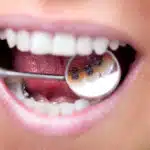Many people are unhappy with their smile and wonder: when do you need braces? You can find the answer to this question and all options here.
Straight teeth and a beautiful smile not only make you attractive but are also an important cornerstone for health and general well-being.
Therefore, if the teeth are not in the ideal position, braces can be an effective solution.
In this article, we will take a closer look at the topic of “When do you need braces?” and highlight the various aspects of braces.
| Get 150 € discount on your dental correction! |

Book a consultation appointment now at a nearby DrSmile partner practice and find out if teeth straightening with aligners is right for you.
The appointment is completely non-binding and does not involve any costs.
With the code “THATSMILE150” you will receive 150 € discount on the treatment.
What you should know about braces
Braces, also known as orthodontic appliances, are a device used to correct misaligned teeth and achieve harmonious alignment.
It consists of various components that are used in close cooperation with an orthodontist.
What exactly is a brace?
A brace is a device consisting of brackets, archwires and, if necessary, elastic bands.
Brackets are small metal or ceramic elements that are bonded to the teeth, while archwires pass through the brackets and create the actual force to move the teeth into the desired position.
There are several types of braces, including traditional metal braces, invisible braces, such as DrSmile’s aligners, or lingual braces, which are placed on the inside of the teeth.

What is the purpose of the brace?
There are several reasons why braces may be necessary. One of the main reasons is orthodontic problems.
When teeth are not properly aligned, it can lead to bite problems, jaw misalignment and uneven tooth wear.
Braces can also be worn for aesthetic reasons to beautify the smile and thus boost self-confidence.
When do you need braces?
The need for braces depends on several factors, including age and the severity of the misalignment.
Braces are usually recommended for children and adolescents between the ages of 10 and 14, as their jaws are still growing and teeth can be corrected more easily.
But braces can still be used for adults at any age.
How do braces work?
Braces act by applying gentle, controlled forces to the teeth. The brackets, which are placed on the teeth, hold the archwire in place, which in turn moves the teeth into the desired position.
As needed, elastics can be used to apply additional forces to specific teeth or jaw areas.
Invisible braces (aligners) are wafer-thin splints that fit snugly over the teeth, where they exert permanent pressure. They are offered by DrSmile, among others.
What are the advantages of braces?
Braces offer many advantages. One of the most obvious benefits is the correction of misaligned teeth.
Correct alignment of the teeth can eliminate bite problems, make chewing easier and reduce the risk of gum disease.
In addition, braces can also improve jaw function and help teeth stay healthy longer.
But the optical advantages cannot be dismissed out of hand either. For many of us, straight teeth and a beautiful smile make a decisive contribution to our general well-being.
| Get 150 € discount on your dental correction! |

Book a consultation appointment now at a nearby DrSmile partner practice and find out if teeth straightening with aligners is right for you.
The appointment is completely non-binding and does not involve any costs.
With the code “THATSMILE150” you will receive 150 € discount on the treatment.
What are the side effects and risks of braces?
As with any medical treatment, there are risks and side effects associated with braces.
Some people experience an uncomfortable feeling and pressure on the teeth at first, but this usually decreases after a few days or weeks.
In rare cases, temporomandibular joint disorders may occur. Particularly thorough oral hygiene is also very important during treatment, as braces can make cleaning more difficult.
How long do you have to wear braces?
The duration of treatment with braces varies with the severity of the malocclusion. As a rule, orthodontic treatment with fixed braces lasts between 1 and 3 years.
Treatment with invisible aligners is often somewhat faster. Mild malocclusions can be corrected in as little as three months in some cases.
After the completion of the tooth correction, it is necessary to wear a retainer to ensure that the teeth maintain their new position.
How to find the right orthodontist?
Choosing the right orthodontist is crucial for successful treatment. It is advisable to ask for recommendations from friends, family or the dentist.
Read reviews and take time for a consultation to get to know the orthodontist and make an informed decision.
Tooth correction with invisible aligners takes place primarily from home. You can find a nearby provider via this link.

Our tip: Aligners as a discreet alternative to fixed braces
A practical and hygienic alternative to fixed braces are the so-called aligners.
These are wafer-thin, invisible dental splints that are made to fit precisely and slipped over the teeth.
Treatment with aligners is completely discreet and painless – it usually lasts only a few months. In addition, the invisible braces are often cheaper to have.
A key advantage of aligners is also that they are removed for eating and for daily oral hygiene.
Treatment with aligners is suitable for mild to moderate malocclusions.
You can find out whether invisible braces are an option in your case during a free, no-obligation consultation appointment, which you can book here.
When do you need braces? Conclusion on the subject
Braces can make your dream of a beautiful, bright smile come true. It not only corrects misaligned teeth, but also improves jaw function and general well-being.
If you have concerns about your misaligned teeth, you should consult an orthodontist to discuss the best treatment options.
Invisible braces are always the best choice if you want to discreetly correct mild to moderate malocclusions. You can find providers in your area and further information here.
| Get 150 € discount on your dental correction! |

Book a consultation appointment now at a nearby DrSmile partner practice and find out if teeth straightening with aligners is right for you.
The appointment is completely non-binding and does not involve any costs.
With the code “THATSMILE150” you will receive 150 € discount on the treatment.
FAQs on the topic: When do you need braces?
At this point we will answer some frequently asked questions about the topic “When do you need braces?
Can you eat normally with braces?
Yes, you can eat normally, but you should avoid hard or sticky foods that could damage the (fixed) braces.
Are braces only for teenagers?
No, braces can be used at any age to correct misaligned teeth.
Are braces painful?
Braces may cause slight discomfort and pressure on the teeth at first, but this usually subsides after a few days.
How long does it take to see results from braces?
The visible results of braces can take several months to years, depending on the severity of the misalignment and individual factors.
How much does a brace cost?
The cost of braces varies depending on the type of braces, the length of treatment and the orthodontist. Invisible aligners are usually cheaper than fixed braces, prices here start from about 1500 euros for both jaws.



Leave a Reply